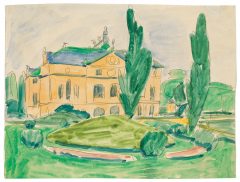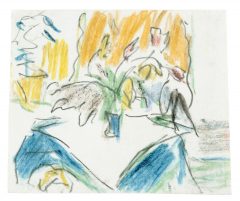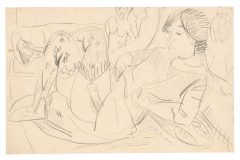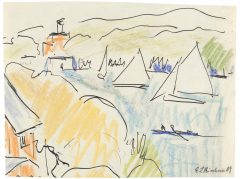Ernst Ludwig Kirchner
Palais im Großen Garten
ca. 1910

Watercolour und pencil on paper
25.2 × 33.7 cm | 10 × 13 1/4 in
With the Basel estate stamp, numbered »A Dre /Ab 18«, and marked »1109« as well as »Vergl. Grohmann Kirchnerzeichnungen Abb 17 Palais im großen Garten 1906« by a third hand on the verso
The work has been registered by the Ernst Ludwig Kirchner Archiv Wichtrach/Bern
Estate of the artist; Private Collection Southern Germany; Kunsthaus Lempertz, Cologne (1964); Galerie Wolfgang Ketterer, Munich (1971); Private Collection Switzerland
- Will Groham, "Kirchner-Zeichnungen", Dresden 1925, see. no. 17
On 7 June 1905 Ernst Ludwig Kirchner, Erich Heckel, Karl Schmidt-Rottluff and Fritz Bleyl founded the artists' association "Brücke" in Dresden, which decisively influenced and advanced Expressionism in Germany. Influenced by the symbolism of French and Scandinavian painters, Kirchner first developed a completely independent style before developing his unmistakable, expressive and innovative style in the early Brücke years, with which he still inspires many subsequent artists today. Kirchner not only shines as a nude artist, but also shows his skills in the depiction of architecture. Art and nature already formed a unity for him in the Dresden years and so our two motifs of the same palace also bear witness to Kirchner's drawing talent. The coloured version "Palais im Großen Garten" and the drawing "Ein Boskett in Dresden, mit Blick auf ein Palais" show from different angles the pleasure palace in the "Großen Garten", which was built from 1678 to 1683 by Oberland master builder Johann Georg Starcke and was intended for the summer amusements of the court. The son of August the Strong, Elector Friedrich August of Saxony, and the Austrian Archduchess Maria Josepha married there in 1719. During Kirchner's time in Dresden, the palace served the Royal Saxon Antiquity Society as an exhibition building for mainly sacred works of art. In both sheets, Kirchner concentrates on the essential features of the building, sketching them in rapid strokes, similar to his famous quarter-hour acts. Through the skilful rhythmization of the composition, Kirchner creates an interesting change for the eye of the beholder. In spite of the great spontaneity that his painting style suggests, the exciting and well thought-out composition of the picture makes it clear that these works are mature works that do not have the character of studies.



